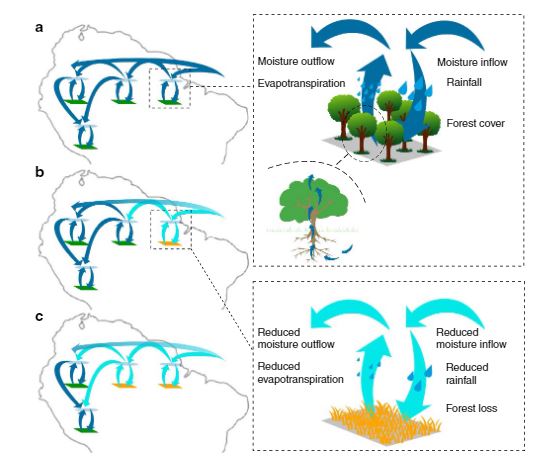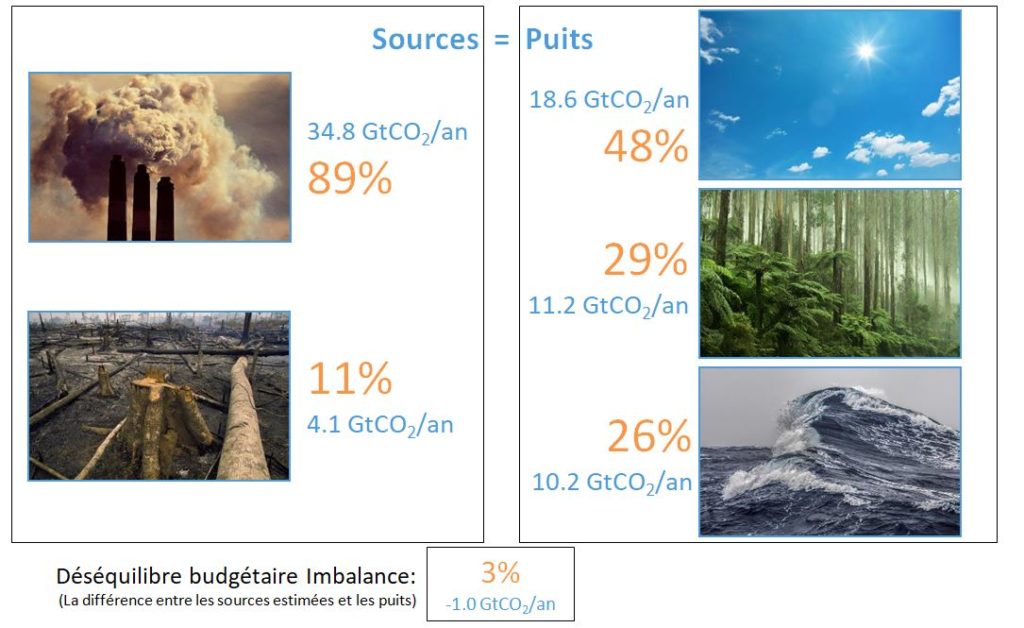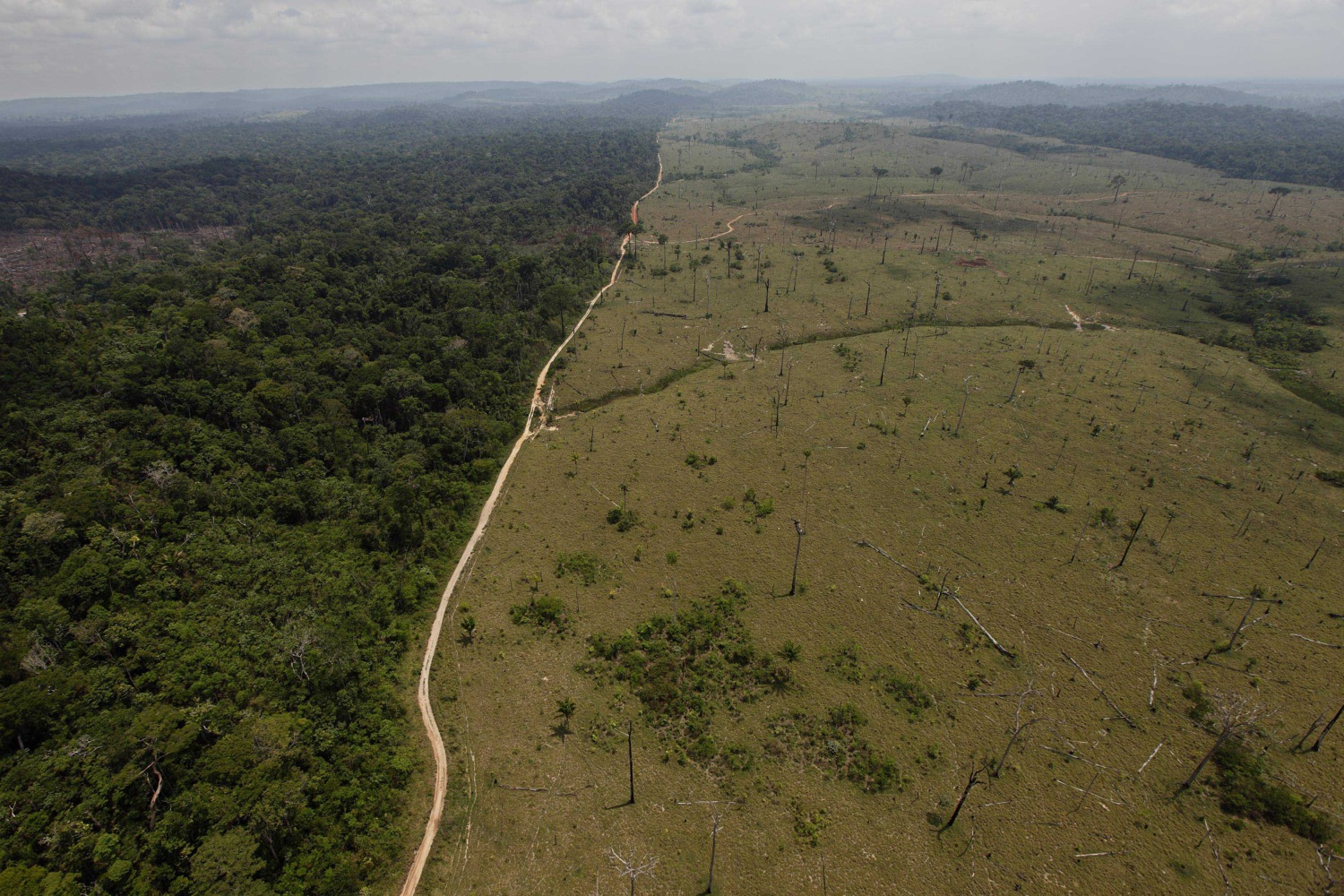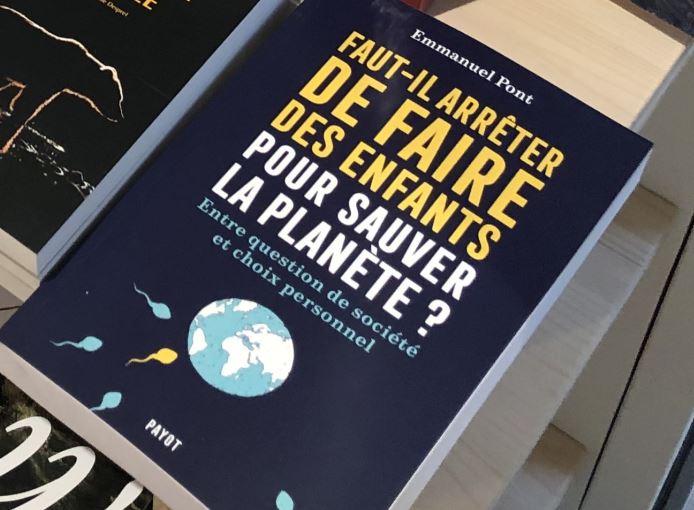The Amazon is perhaps the first topic in our climate series that 100% of our readers have heard of. This natural region of South America that we studied at school is so immense and rich that it can’t leave anyone indifferent.
The Amazon rainforest is often under the spotlight because of the massive deforestation it has been undergoing for decades. However, this year’s news has gone wild: the large-scale deforestation of the Amazon forest could turn it into… a savanna.
How could a tropical forest possibly become a savanna? Is it even possible? And as simple as headlines announced it? Is the Amazon rainforest really “the green lung of the planet”?
Emilie Joetzjer, a researcher at INRAE helped us to answer these questions.
The Amazon is more than a forest
The richness of the Amazon is so great that it would take several books just to outline it. The Amazon is the world’s largest rainforest, covering over 5.5 million square kilometers. The forest spans across nine countries: Brazil (67%), Bolivia (11%), Peru (13%), Colombia, Venezuela, Ecuador, and Guyana (France), Suriname and Guyana.
Only a few orders of magnitude can make this clear:
- 390 billion trees and about 16,000 different species, representing 13% of the total number of trees on the planet.
- It hosts 10% of the world’s biodiversity, and scientists specify that thousands of species are still unrecorded. Each tree species hosts, on average, 150 different insect and plant species (By contrast, it’s only 10 in France).
- The Amazon represents half of the world’s tropical forests.
- It covers over 5.5 million square kilometers, i.e. 10.% of the world’s land surface.
Contrary to what is generally believed, the Amazon rainforest is not uninhabited, it’s quite the opposite. At least 34 million people live there, mainly indigenous populations and local communities (IPLCs), covering about 35% of the Amazon. And, you will not believe it! These are not people whose brains have told them to destroy their environment… For this reason, we should give them the place they deserve at the climate talks.

Local deforestation, global issue
Massive deforestation in the Amazon did not start in the early 2000s… but was already happening in the 1960s! It was driven by government incentives to clear lands for agricultural production, which coincided with more efficient tools such as chainsaws and bulldozers (technological innovation!).
The deforestation rate increased during the ’70s and ’80s, when agricultural subsidies and infrastructure projects, such as highways, dams and mines, attracted workers and industry to the rainforest. In 1988, satellite images revealed that the Amazon had already lost more than 10% of its original area.
Between 2005 and 2012, Brazil – which hosts more tropical rainforest than any other country and half of the Amazon forest – significantly reduced deforestation by 80 %. Emissions drastically decreased as a result. Better surveillance of the forest, better law enforcement, more efficient agricultural practices, and private sector initiatives to stop the sale of goods grown on illegally deforested land have helped to reduce the rate of deforestation.

(in thousands of km²/year)
Source: INPE, via Statista
Two orders of magnitude to bear in mind when considering the Amazon:
- Over the last forty years, 800,000 km² – i.e. 1.5x France – have been destroyed (see image below).
- Between 2000 and 2018, deforestation reached 513,016 km2, an area as large as Spain, or 8% of the global surface area.
A slight lull… before Bolsonaro
While deforestation rates slowed in the early 21st century, they have recently rebounded. For example, deforestation rates in Brazil’s Amazon rainforest have increased since 2018 and hit the highest annual level in a decade. Deforestation rose 85% in 2019 compared to the previous year. These impressive figures coincide with when Bolsonaro – a notorious climate denier – took office as the new Brazilian president.
According to Carlos Nobres – a world expert on the Amazon – about 17% of the Amazon rainforest has been deforested, mainly for cattle breeding and soya plantations. Despite the claims of crimes against humanity, this is clearly not going to stop. By declaring to the United Nations “It’s a fallacy to say Amazon is the heritage of humankind“, the message is clear: he does as he pleases. Deforestation, arson and intensive agriculture have a bright future ahead of them. And so much for the consequences.
How is deforestation observed and monitored?
Monitoring a forest as large as the Amazone’s means monitoring a forest several times the size of France. Only one solution: satellite images.
Brazil’s National Institute for Space Research (INPE) provides access to data from the PRODES satellite system via the TerraBrasilis portal for monitoring the Amazon deforestation. The data transparency policy, adopted by INPE in 2004, allows full access to all information generated by the monitoring systems. INPE auditors perform daily validation of the quality of deforestation data. They currently report 95% of accuracy in the data.
It used to take several months or even years to get results. The monitoring team now receives images on a daily basis and can therefore alert officials the very next day, especially for suspicious activities. In 2017, the INPE already warned of deforestation hitting its highest rate in a decade. About 7,900 km² of the rainforest was destroyed, which corresponds to one million football fields.

Since Jair Bolsonaro came to power, the situation has only gotten worse. As deforestation is a highly political issue, the sovereignty of the states that ‘share’ the Amazon must be set against their role in global warming and its global consequences. Being interested by the Amazon and its likely tipping point (i.e. switch from rainforest to savanna) also means understanding the political and geopolitical forces at work.
NB: answering the question “who owns the Amazon?” is not the subject of this article, but if you are interested, here is a very well done video.
Effects of Deforestation on the Amazon
The effects of deforestation are many and varied. Since Bolsonaro and his accomplices wanted “to bring progress to the Amazon“, risks to biodiversity, climate and millions of people have increased. Here are the main ones.
1/ Disrupted water cycle
Thanks to Eneas Salati, we know that the Amazon recycles about 30% of the total rainfall in the basin via tree transpiration and soil evaporation: this is evapotranspiration.
This is the most important point to understand the rest of this article: deforestation disrupts the water cycle in the Amazon. Fewer trees means less rainfall, and therefore more drought.

Source: Zemp & al. 2016
More specifically: fewer trees mean less rain, higher risks of droughts and thereby a closer tipping point of switching from rainforest to savanna. Researchers then investigated how much deforestation would alter the cycle until reaching a tipping point, i.e. the hydrological cycle could no longer support the rainforest ecosystems.
Add to that the effects of climate change, and you obtain the perfect recipe for disaster. If the water cycle is altered, this would be especially true for droughts, floods, river hydrology, aquatic life, etc.
2/ Increased Climate Hazards
Carlos Nobre already wrote about it in a Science paper published in 1990: “if certain parts of the Amazon are destroyed, it will turn into a savanna. The post-deforestation climate will no longer be a wet climate like in the Amazon. It will become drier, with a much longer drought season, like the long drought seasons in the savannahs of the tropics in Africa, South America and Asia“. The idea is therefore not new, and as we shall see, dozens of studies have since been published on the subject. Two important points to remember:
- WITHOUT climate change and with 40% of the Amazon deforested, we are likely to reach a tipping point (especially in the North and South East).
- With climate change, the tipping point could be reached with only 20 to 25% deforestation! In the end, 50-60% of the Amazonian forest would exist as a savanna.
17% of the Amazon has already been deforested, that droughts (including 2005, 2010, 2015-2016) and fires gradually degrade the state of the forest, and that more droughts and deforestation are expected in the future, the repeated warnings of scientists about the risk of a “tipping point” are well-founded.
3/ Increased CO2 Emissions and Global Warming
This is certainly the most publicised consequence of deforestation: it leads to an increase in CO2 emissions and a decrease in carbon absorption by the trees, since there are fewer of them! The Global Carbon Project 2021 report has just been published and indicates that on average, this represents 4.1 GtCO2/year on a global scale over the last 10 years.

Source: Friedlingstein et al 2021; Global Carbon Project 2021
Translation: Bon Pote
Over the past decade, global net CO2 emissions from land use change were 4.1 billion tonnes, with 14.1 billion tonnes of CO2 emitted by deforestation and other land use changes, and 9.9 billion tonnes of CO2 eliminated by forest regrowth and soil regeneration. To understand the details and uncertainties of the calculations, the report is here.
Last but not least, Philippe Ciais explains: “We realise that even if the forest is not cut, it can lose a lot of carbon by being degraded. Either by undergrowth fires, which do not kill the large trees but impoverish the lower floors, or by selective removal of valuable trees. We showed that three quarters of carbon losses come from these degradations, not from deforestation..
4/ Populations Risk and Biodiversity Erosion
If part of the Amazon rainforest has already been cut down and the remaining part is already threatened, this has direct consequences for biodiversity, and therefore for the people living in the Amazon. The IPBES report published in 2019 already warned about this: entire populations live solely on their immediate environment. If you replace this biodiversity with intensive monoculture, indigenous populations – if not already threatened with death – will be forced to migrate to survive.
Climate and biodiversity are inseparable, as the IPCC and IPBES remind us. If we do not move away from this anthropocentric vision, where only the interests of mankind count, we run the risk of a collapse of the system in which we have been stuck for at least 50 years. It should also be remembered that the IPBES warns of the risks of zoonoses (a disease or infection that can be naturally transmitted from vertebrate animals to humans) of which the Covid gives us a glimpse of what could happen if we continue deforestation and soil artificialisation.
Chaque semaine, nous filtrons le superflu pour vous offrir l’essentiel, fiable et sourcé
Is the Amazon rainforest really “the green lung of the planet“?
Before answering the question of the tipping point, let’s go back to a common misconception about the Amazon, often presented as “the green lung of the planet”.

Firstly, and in the same way, as the oceans are sometimes called “blue lungs”, a lung does not produce oxygen, it inhales it! Also, the Amazon does not produce oxygen. This is true at the level of the leaf, but the whole ecosystem is more or less in balance. Secondly, the focus here is on the net carbon balance. It is more accurate to call the Amazon rainforest, as a tropical rainforest, “an air conditioner of the Earth“.
Indeed, during photosynthesis the forest converts atmospheric CO2 into energy stored in the soil and the wood, and releases oxygen. The forest also breathes, and releases some CO2 into the atmosphere. As it absorbs more CO2 than it releases, the Amazon forest is said to be a carbon sink. Today, about 1/3 of anthropogenic CO2 emissions are absorbed by the continental biosphere, mainly forests.
Nevertheless, the carbon sink capacity of the forest has been declining (Brienen et al. 2015) since the 1990s. The Amazon rainforest is absorbing less carbon because of climatic hazards, including the intense and ‘exceptional’ droughts that have hit the basin several times in the last three decades.
The more CO₂ emissions continue in the future, the less the natural system will be able to absorb carbon to offset some of our emissions, creating a positive feedback. “Under scenarios of increasing CO2 emissions, oceanic and terrestrial carbon sinks will be less effective in slowing the accumulation of CO2 in the atmosphere.”

Now that we have all the elements in hand, let us tackle the famous subject of tipping point.
What is a tipping point?
Although the principle has been known to scientists for several decades, it is only recently that the tipping point has been used explicitly. The IPCC refers to it for the first time in its 4th report, and since in every report (and special reports). In its Special Report 1.5, the tipping point is defined as follows:
The degree of change in the properties of a system beyond which the system in question reorganises, often abruptly, and does not return to its original state even if the factors causing the change are eliminated. For the climate system, the tipping point refers to a critical threshold beyond which the global climate or a regional climate moves from one stable state to another stable state.
Irreversibility is an important concept: “a term describing the disturbed state of a dynamic system on a given time scale, when the time required for the restoration of the system by natural processes is significantly longer than the time required to reach this disturbed state“.

on climatetippingpoints.info
Note that these tipping points can either be caused by natural climate fluctuations or by external forcing, such as global warming. These tipping points, which are likely to occur in the next one to two centuries (or even earlier) with anthropogenic emissions, are likely to lead to an irreversible trajectory. It would take centuries, if not millennia, to return to the original situation.
These tipping points are many and varied: there is of course the Amazon forest, but also the melting of the Arctic ice pack, the partial (Antarctic) or total (Greenland) ice caps melting, changes in thermohaline circulation, the switch of the Amazon from rainforest to savanna, the weakening of the Indian summer monsoon, permafrost thaw (which would release greenhouse gases), etc. Here is a map that summarises the main theoretical tipping points after a certain degree of global average warming:

Source: Will Steffen et al. PNAS 2018
How concerned should we be?
Global warming does not induce a “linearity” of impacts: the consequences of a warming of +3°C are not simply “twice” the consequences of a warming of +1.5°C. They are indeed much more serious, with the risks of “positive feedback loops“.
It is also essential to understand that these tipping points are difficult to define, and once triggered, do not necessarily lead to an abrupt and immediate change in climate : in the case of sea level rise, for example, the consequences can take centuries or even millennia to be felt once the ‘threshold’ is passed.
Has the Amazon rainforest reached a tipping point?
There are several elements to consider when talking about the tipping point in the Amazon. Every scientific paper published on the subject makes the headlines, sells a lot of papers… But this does not reflect the complexity of the phenomenon and the limitations of the studies.
Let’s answer the question in five points.
1/ Well defining the “tipping point”
The year 2021 has been very rich in scientific publications focusing on the Amazon and the possibility of a tipping point. But it is important to know what we are talking about.
First of all, “what tipping point”: here, the switch of the Amazon from rainforest to savanna. The whole press got excited about the publication of Gatti & al (2021) mentioning a tipping point, but the study is not about the same thing! Indeed, the study explained that Amazon was no longer a carbon sink, but a source of CO2. Again, you have to read the study and the methodology, which turns out to be much more complicated than the headlines.
Next, it is important to know the perimeter of the tipping point. Indeed, are we talking about the whole of the Amazon, or just one geographical area? Over the past 40 years, the eastern Amazon has been subjected to more deforestation, warming and water stress than the western part, especially during the dry season, with the southeast experiencing the strongest trends.
2/ What does the IPCC say about the tipping point in Amazon?
Despite what you may have read or heard, the IPCC has not ignored these climatic phenomena at all, and has in fact documented them very well in the Working Group 1 of AR6. The level of uncertainty and the risk of passing through ‘tipping points’ were both associated with each tipping point. All this is of course also being studied, in particular with climate models, which aim to understand how these tipping points may have occurred in the past, and what the risks are of this happening in the next century or two.
In the 6th report, the IPCC does not rule out a tipping point for the Amazon, with more details than in the previous report:
C.3.2 The probability of low-likelihood, high-impact outcomes increases with higher global warming levels (high confidence). Abrupt responses and tipping points of the climate system, such as strongly increased Antarctic ice-sheet melt and forest dieback, cannot be ruled out (high confidence)..
AR6 chap.1: “At the regional scale, abrupt changes and tipping points, such as Amazon rainforest dieback and permafrost collapse, have occurred in projections with Earth System Models (Section 4.7.3; Drijfhout et al., 2015; Bathiany et al., 2020)”Box TS.9: “At the regional scale, abrupt responses, tipping points and even reversals in the direction of change cannot be excluded (high confidence). Some regional abrupt changes and tipping points could have severe local impacts, such as unprecedented weather, extreme temperatures and increased frequency of droughts and forest fires”.
“Continued Amazon deforestation, combined with a warming climate, raises the probability that this ecosystem will cross a tipping point into a dry state during the 21st century (low confidence). (See also Box TS.9). {4.8, 8.6.2}”

The degree of confidence associated with each “tipping point” can be seen
3/ Criteria and uncertainties around the tipping point
It is extremely complicated to say that a tipping point will be reached in the Amazon, because it depends on several scientific, but also political elements:
- Local and political uncertainty: the future of deforestation can not be predicted with certainty, as it depends on political decisions. You never know, Bolsonaro might take the historic decision to stop deforestation and undertake a gigantic reforestation plan! Why not.
- Global uncertainty: warming is global and it will not only depend on the countries where the Amazon is located. Remember that CO2 has no borders and that the Amazon suffers as much from German coal mines as from a French influencer who makes weekend trips to Dubai.
- Scientific uncertainty: research is continuing and progressing on the subject, both on the forest’s response to global change, and on the estimation of the probability of a tipping point. A tipping point used to be estimated at 40% deforestation, now it is more like 20-25%, with climate change. Another point is that there is still uncertainty as to whether this tipping point will be reversible or not.
Not only CO2 should be considered. Two other issues have recently been addressed in more detail:
- the underestimated impact of methane, which is produced by anaerobic effect. It is very present in mangroves, but also in very wet forests.
- the impact of the decrease in evapotranspiration, which will modify the micro-climate or rather the local climate at the Amazon scale.
4/ Cascading effects
The last IPCC report indicates that with global warming, each region could experience more extreme weather events, sometimes cascading, with multiple consequences. This is more likely to happen with +2°C warming than 1.5°C (and even more so with additional warming levels). Understand “Risk cascading” as multiple simultaneous risks.
This has been supported by the latest scientific studies in the Amazon. Climate change leads to an intensification and lengthening of the dry season and an increase in the frequency of droughts, which is further amplified by deforestation. These conditions increase the risk of wild fires. These different stresses affect the trees which become weaker and more susceptible to diseases.
At what degree of global warming would there be a tipping point?
In 2016, three scientists explained that, according to them, “the right climate targets were chosen in Paris” (when the Paris Agreement, to keep the rise in mean global temperature to well below 2°C above pre-industrial levels, and preferably limit the increase to 1.5 °C). To demonstrate their points, they showed – in the figure below – that these targets (“Paris range”, in grey) make it possible to avoid as much as possible triggering potentially disastrous tipping points (the colour from yellow to red indicating the level of risk of “tipping”).
Although some studies show that4°C of global warming would be the tipping point to degraded savannas in most of the central, southern, and eastern Amazon, it is very difficult to estimate with certainty. What is known with certainty is that the problems already exist, that they are likely to continue and to get worse and worse because of the non-linearity of climate risks.
Solutions to avoid the worst!
After all the bad news about the Amazon switching into a savanna, it is important to know that the worst can still be avoided! Several concrete actions to avoid this tipping point:
- Reduce intensive commercial agriculture, including cattle grazing, soy, palm oil, coffee, etc.
- Reduce mining and logging
- Reducing emissions from deforestation and forest degradation (REDD+): focusing on putting a monetary value on the carbon stored in forests, thereby providing an incentive for developing countries to reduce CO2 emissions from deforestation and to invest in low-carbon development models to achieve sustainable development. By the way, a study by Heinrich et al., (2021) suggests that tropical secondary forests sequester carbon up to 20 times faster than old-growth forests!
- Regulate finance, including commodity trading.
- Better management of the common goods: consider the Amazon as a common good that does not only belong to the 9 countries it crosses, and that is necessary for the survival of a part of humanity.
So while Bolsanaro is completely irresponsible on climate issues, he is not the only one to blame. The whole chain is responsible, from production to consumption.
Billions of euros are at stake, and Bolsonaro or not, the whole economic system has to change. C. Nobre believes that if companies push for a deforestation-free supply chain and are very rigorous about it, deforestation would stop in less than 5 years. You probably have recognised some the name of some of the people involved in fires and deforestation in the Amazon…
The last word
Defining and estimating a tipping point in the Amazon is as complex as complicated. Take-home messages:
- The Amazon is the largest rainforest in the world (5.5 million km²) and spreads over nine countries.
- In 40 years, the Amazon forest has lost about 17% of its surface.
- The Amazon forest is a carbon sink that helps absorb some of our emissions.
- Deforestation has a broad impact: it disrupts water cycle, increases CO2 emissions, drives biodiversity erosion, and makes thousands (or even millions) people to migrate.
- The carbon sink capacity of the Amazon rainforest is ‘under threat’, not only from deforestation but also from droughts, forest fires and the combined effects.
- The tipping point refers to a critical threshold beyond which the global or regional climate moves from one stable state to another.
- Focusing only on the carbon sink role of the Amazon is a mistake. Deforestation also impacts biodiversity and the millions of people who live there.
- A tipping point may be reached first in the south-east of the Amazon, but not for the entire Amazon forest.
- We still have the physical and political means to preserve the Amazon forest!

















